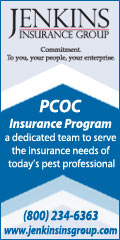
| January 2012 | Past Issues | Printer-Friendly | Advertise | Affiliates Search | Find a Pest Control Operator | PCOC.org |
|
EVP NOTES
Happy New Year! I hope this New Year brings you Happiness, Prosperity and Peace. This time next year we will be looking back at 2012 and from a political perspective, there are a great many potential changes that may occur. There are new legislative and congressional district drawn up, for the first time, by an independent commission – instead of the politicians. The fox will no longer be guarding the hen house! There is a new "top two" primary election system in place. There is a chronic state budget crisis (so what else is new – really!), potentially dozens of ballot initiatives and a state economy that is starting to emerge from a deep recession...and a presidential election where California may play some part in choosing the Republican challenger to President Obama. The new legislative districts, in theory, should produce a more moderate legislature with fewer legislators single-mindedly committed to their political backers and more willing to negotiate and compromise. Governor Brown hopes that voters will raise taxes next year by ballot initiative. However, his ballot initiative is just one of several tax measures headed to the November ballot. Unless the Governor can clear the field, the water will be so muddy that all of these ballot measures could be doomed. Of course, being California, raising taxes isn't the only issue that voters will decide via the ballot initiative: others include eliminating the unions' power to collect political funds from members' paychecks automatically, returning the legislature to a part time body, a state spending limit (where have I heard that before?!) and overturning the Dream Act college aid for illegal immigrants. There will only be a few ballot initiatives in June because the Governor and the legislature decided that everything will be in November when turnout is higher and thus minimize the chances of the union paycheck protection measure passing. The result is that Democratic turnout in June will be very low while Republicans could have a rare chance at influencing the GOP's presidential nomination if the multi-candidate race is still unresolved. A bumper political year! OPEN POSITION PCOC DIRECTOR OF MEMBERSHIP AND TECHNICAL SERVICES JOB DESCRIPTION The position will be responsible for growing the association membership as a dynamic, energetic and dedicated staff member. The successful candidate will also respond to technical questions relating to the pest control industry that come in to the PCOC office. In addition, other association duties as directed by the EVP, such as responsibilities at the quarterly Board of Directors meetings, Leg Day, Leadership Academy and at the association's annual Convention/Expo and at other PCOC events as needed. On the membership side, this person will develop and implement strategic plans to increase membership and retain existing members. Specifically, this includes, but is not limited to, visiting prospective and current members throughout the state, attending district meetings, attending trade shows and appreciation days and developing contests and other incentives for joining PCOC. This person will reach out to non-members by updating the PCOC database and sending out new member packets and will retain existing members by following up on delinquent accounts and keeping the association member database current. Also, this person will respond to membership inquiries that come in to the PCOC office. On the technical side, this person will respond to technical inquiries. He/she may attend meetings of DPR's PMAC & PREC Committees and meetings of the Structural Pest Control Board and its subcommittees as necessary. The successful candidate may also testify at committee hearings of the California Legislature as needed. The successful candidate will be an enthusiastic, active self-starter with sales experience. This person will also have some knowledge of the pest control industry in California. The position will report to the Executive Vice President of PCOC and is based in the PCOC Executive Offices in West Sacramento. Salary is commensurate with experience and includes a bonus package. Health and dental insurance are available. Interested persons should send their resume, with references, to jobs@pcoc.org, together with a cover letter stating why they are the most suitable candidate for this important position. LEGISLATIVE UPDATE
UPCOMING EVENTS
2012
March 23-24
Board of Directors Meeting Seascape Beach Resort Aptos, CA April 24-25 Leg Day 2012
Hyatt Regency Sacramento
Sacramento, CA
June 1-2 Leadership Academy
Silverado Resort
Napa, CA
June 21-23 PCOC Expo 2012
Catamaran Resort
San Diego, CA
Sept. 28-29 Board of Directors Meeting
Hyatt Regency
Monterey, CA
Dec. 7-8
Board of Directors Meeting
Hilton Palm Springs
Palm Springs, CA
VIEWPOINT
SPCB: Focus on Education and Compliance
By Bill Douglas
Twenty-one months ago, I began my career with the Structural Pest Control Board as the chief enforcement officer after departing the California State Athletic Commission where I served as the assistant executive officer and acting executive officer regulating California's combat sports population for professional and amateur boxing, kickboxing and mixed martial arts. In my previous capacity, I oversaw day-to-day operations encompassing administrative, licensing and enforcement functions. That experience assisted me greatly in my transition to the board working in enforcement and now as the interim executive officer and registrar regulating the pest management profession. We need a strong and equitable compliance and enforcement program to ensure consumers are protected and the playing field is level for licensees. To carry this out, we must promote clear and well-defined rules, educate licensees, maintain effective licensing practices and operate with transparency. The primary goals of a good enforcement program should be education and compliance. Disciplinary action, or punishment for lack of a better word, should be used when appropriate in a fair and consistent manner. I have great respect for the pest control industry, business owners and staff members who perform the work on a day-to-day basis. It is hard work and I value that. In order to complement your work, one example of change in the board's enforcement activities is the monitoring of filing wood destroying organisms activities implemented on Aug. 1, 2011. This action was taken to ensure that all companies are filing the activities that are mandated by law. After all, if your company is doing business "the right way" by filing activities and paying fees on time, shouldn't your competitor be held to the same standard? Another example of change in enforcement practices is diligent pursuit of unlicensed pest control practitioners. To do so, the board has employed tactics such as undercover operations and following up on any lead received in our offices regardless of whether it is submitted by named or anonymous sources. Again, the playing field must be level and all pest control practitioners shall be properly licensed. A third example of the enhanced enforcement practices is the strict monitoring of probationary licensees. The board values second opportunities given to qualified candidates for the probation program. After all, the greatest gift of education is to learn from previous mistakes that may have occurred during the course of an inspection. However, to ensure that consumers remain protected and the probationary licensee is properly educated to become successful in his or her future endeavors, meticulous attention to probation cases is now being employed by board staff. To reiterate, my role is to be fair and equitable in treatment of our licensees and to make decisions that are subjected to careful review of a situation or problem. I look forward to working with each of you. Please contact me if you have any ideas on how we can improve our educational efforts and enforcement. Bill Douglas is the Interim Executive Officer/Registrar for SPCB MEMBER VALUE PROGRAM
PCOC MONTHLY INSURANCE/SAFETY TIP
Workplace violence is a major concern for employers and employees nationwide. Homicide is the leading cause of death for women in the workplace. According to the Bureau of Labor Statistics Census of Fatal Occupational Injuries, workplace homicides accounted for 506 (11 percent) of the 4,547 fatal workplace injuries in the United States in 2010. And nearly two million American workers report having been victims of workplace violence each year. Unfortunately, many more cases go unreported. Who is at risk of workplace violence? The truth is, workplace violence can strike anywhere, anytime, and no one is immune. However, research has identified factors that may increase the risk of violence for some workers. These include: · Exchanging money with the public · Working with volatile, unstable people · Working alone or in isolated areas · Providing services and care · Working where alcohol is served · Working late at night or in areas with high crime rates Workers at higher risk include workers who exchange money with the public, delivery drivers, healthcare professionals, public service workers, customer service agents, law enforcement personnel and those who work alone or in small groups. Preventing Violence
OSHA recommends a "zero-tolerance policy toward workplace violence," while the FBI says "employers should adopt clear no-threat and no-violence policies and prevention plans." An employer should prevent the root causes of workplace violence by "creating an atmosphere of fairness, trust and cooperation between employees and management," says the FBI's National Center for the Analysis of Violent Crime. Other recommendations include: • Communicate anti-violence policies to employees • Survey employees to get their ideas about the risk of violence and preventive measures • Train employees to recognize the warning signs of violence • Provide violence prevention training for managers, especially regarding downsizing and termination procedures • Provide physically secure workplaces • Adopt staffing policies that keep staff safe on the job • Cooperate with unions and other local businesses on employee safety • Formulate action plans so managers and supervisors know what to do when violence occurs "There is not one absolute factor that predisposes an individual to workplace violence," says Eugene A. Rugala, supervisory special agent for the FBI's National Center for the Analysis of Violent Crime. "Managers and employees should be familiar with each potential warning sign, but look at a totality of factors including the work environment, the employee's home life and his or her behavior as a whole." Managers and employers should beware of focusing too much on dysfunctional and violence-prone individuals, while not paying enough attention to the dysfunctional workplace, say Richard V. Denenberg and Mark Braverman, the authors of a book called The Violence-Prone Workplace: A New Approach to Dealing with Hostile, Threatening, and Uncivil Behavior. They identify failure to recognize and defuse conflicts as the primary causes of workplace violence. "It is not enough to have an anti-violence policy on the wall and an employee manual on the shelf that purports to address the problem," adds Larry Chavez, an expert on workplace violence and crisis communications. He recommends providing formal instruction for managers to recognize and eliminate organizational risk factors that have led to violence in other organizations. "They must also be instructed in defusing hostile employees so as to prevent an angry outburst from escalating into violence." For more information on preventing workplace violence, see OSHA's website at www.osha.gov/SLTC/workplaceviolence/index.html or contact the PCOC Insurance Program department of Jenkins Insurance Services at (877) 860-7378. NEW MEMBERS
FREQUENTLY REQUESTED INFORMATION
TEMPORARY NPMA LOGIN FOR JOINT MEMBERSHIP LOGIN: 313501 PASSWORD: PCOC PCOC website password for 2011-2012 effective July 1, 2011:"npma" Department of Fish & Game Department of Food & Agriculture Department of Pesticide Regulation Find Your Legislator Healthy Schools Act Structural Pest Control Board |
Pest Control Operators of California |
 |






